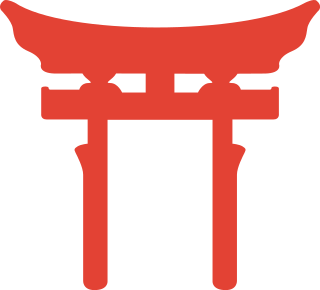
The Tale of the Bamboo Cutter is a 10th-century Japanese monogatari containing Japanese folklore. It is considered the oldest extant Japanese prose narrative although the oldest manuscript dates to 1592.

The Shoku Nihongi (続日本紀) is an imperially commissioned Japanese history text. Completed in 797, it is the second of the Six National Histories, coming directly after the Nihon Shoki and followed by Nihon Kōki. Fujiwara no Tsugutada and Sugano no Mamichi served as the primary editors. It is one of the most important primary historical sources for information about Japan's Nara period.
The Sangyōsho is the title of three annotated commentaries on important Buddhist sutras: Hokke Gisho (法華義疏), Shōmangyō Gisho (勝鬘経義疏), and Yuimagyō Gisho (維摩経義疏).
Renri Hishō is a text on renga poetics. It was written by Nijō Yoshimoto around 1349. It had a great influence on the development of renga.

Kogo Shūi (古語拾遺) is a historical record of the Inbe clan of Japan written in the early Heian period (794–1185). It was composed by Inbe no Hironari (斎部広成) in 807 using material transmitted orally over several generations of the Inbe clan.
Ukiyoburo (浮世風呂) is a Japanese novel written by Shikitei Sanba between 1809 and 1813. It belongs to the kokkeibon genre, of which it is one of the masterpieces.
Tsutsumi Chūnagon Monogatari is a post late-Heian period Japanese collection of short stories.
Nihon Ryōiki (日本霊異記) is an early Heian period setsuwa collection. Written by Kyōkai between 787 and 824, it is Japan's oldest collection of Buddhist setsuwa. It is three volumes in length.
The dangibon (談義本) was a pre-modern Japanese literary genre. Texts were written in a humorous, satirical sermon-style with the purpose of educating the masses. It is type of gesaku.
Nihon Kōki (日本後紀) is an officially commissioned Japanese history text. Completed in 840, it is the third volume in the Six National Histories. It covers the years 792–833.
Shoku Nihon Kōki (続日本後紀) is an officially commissioned Japanese history text. Completed in 869, it is the fourth volume in the Six National Histories. It covers the years 833-850.
Nihon Montoku Tennō Jitsuroku, abbreviated as Montoku Jitsuroku, is an officially commissioned Japanese history text. Completed in 879, it is the fifth text in the Six National Histories series. It covers the years 850-858, the years of reign of the 55th Japanese sovereign, Emperor Montoku (827-858).

Utsubo Monogatari is a late 10th century Japanese story. It is Japan's oldest full-length narrative.
Sumiyoshi Monogatari (住吉物語) is a late 10th century Japanese story. Along with Ochikubo Monogatari, it is representative of Japanese Cinderella-type literature dealing with stepmother bullying and harassment. It belongs to the tsukuri monogatari genre.

Yoru no Nezame is a c. 11th century Japanese story. It is one of the major representative Heian period texts. It is a courtly romance and belongs to the tsukuri monogatari genre.

Mumyōzōshi is an early 13th-century Japanese text. One volume in length, it is the oldest existing Japanese text on prose literary criticism. The author is unknown, but the leading candidate proposed is Shunzei's Daughter. Other candidates who have been proposed include her maternal grandfather Shunzei himself and the monk Jōgaku (上覚).
Aki no Yo no Naga Monogatari (秋夜長物語) is a Japanese otogi-zōshi from the Nanbokuchō period.
Aisome-gawa is a Japanese otogi-zōshi. The text dates to the Muromachi period, and survives in a single manuscript in the possession of the Keiō University Library. It is an adaptation of an eponymous Noh play.
Komachi Monogatari (小町物がたり) is a Japanese otogi-zōshi in two volumes, composed late in the Muromachi period or the beginning of the early modern period.
Tenshō-daijin Honji (天照大神本地) is a Japanese otogi-zōshi in one book, composed in the early sixteenth century.











